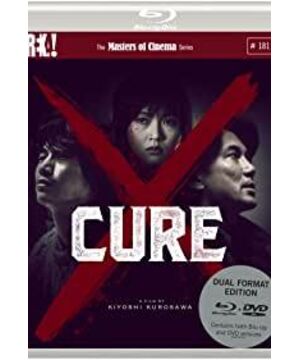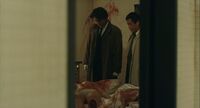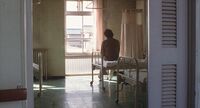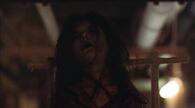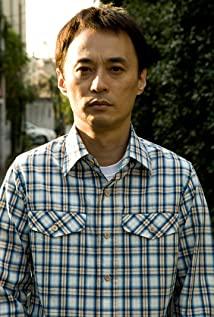"Hypnosis" as the core concept is directly expressed in the film as Mamiya uses hypnotism to cause people of different professions and identities to kill objects they dislike in their hearts to obtain "cure". This is hypnosis in the superficial sense, and the internal world of the text constructed by Kiyoshi Kurosawa is itself a hypnotized state. At the same time, he also revealed the hypnosis of the social spirit through four murders.
The first murder is still the shooting method of ordinary thriller horror movies, with brisk music, translucent shower curtain, and blood slowly sliding down and dripping. When the high-level police detective came out, he entered another room from the scene of the dead body. The shot was close-up from the perspective, and the POV shot was moved across the room. The murderer's wallet stayed in the room. The high-level picked up the wallet and stared back to the close-up. The corpse on the bed, zoom, and then cut directly (for the first time) to the front of the corpse. We saw the "X" on the victim's neck. The thrilling and curious performance will make us naturally think that the murderer is a vicious perverted killer. , The case is also a bloody spectacle that is equally astonishing and appalling.
But after this introduction, Kurosawa Kiyoshi began to use a series of daily plot arrangements and psychological hints to overthrow this established understanding. In the next scene, Takabe and Sakuma are discussing the case while he is eating. This detail corresponds to his inability to eat in the restaurant during the hypnotic confrontation and the restoration of appetite after being "cured" at the end.
Along with the deep, continuous and repressive soundtrack on the beach, Mamiya appears for the first time, the narrative turns into a metamorphosis, and Kurosawa Kiyoshi really begins to hypnotize the audience. The next three murders were not explained in sequence, but were presented in an overlapping and progressive manner of "hypnosis-pre-homicide, post-interrogation". These three cases plus the communication between the senior and his wife (on the surface, the piano and the naruto, but actually dragged each other ) Together constitute the whole process of one person killing another in daily life. The identities of the murderers are teachers, policemen, and doctors, indicating that there is a potential murder image in any profession or anyone. On the contrary, the normal state in the eyes of ordinary people is the hypnotic restraint, regulation or shaping of the sick society. Mamiya’s behavior is a kind of anti-hypnosis, arousing the most instinctive primitive impulse and self-emotional mobilization ability. Therefore, the seemingly uncaused, manipulated killings are actually "caused". Thinking about it this way, it does not matter whether Mamiya exists or not. He is just a "guide", eliminating the high concept of "hypnosis", "everyone There is the possibility of murder." This is the real horror of this movie. Its essence is that the teenager at the beginning of John Carpenter’s "Moonlight Panic" killed the whole family for no reason, and that teenager is a symbol of social illness." "X" externalized the gradual recovery of the pain that spread to every corner in the external paralysis. This also explains why hypnosis was considered psychic in the 19th century and was suppressed by the rulers.
In the plot organization of several hypnotic killings, Kurosawa used more casual details to lay out the daily hypnotic factors: regular visual dynamics and sound frequencies. For example, the flashing tube lights and dripping broken water pipes in the tunnel at the beginning (corresponding to Mamiya’s hypnotic method: lighters and water drops in the cup), this scene reappeared after the teacher killed his wife’s mental disorder. To me, this is all Except for the scariest part at the end of the film, it gives a psychological hint of a terror (hypnotic) factor spreading in all inconspicuous corners of the urban air. It is also a lens that can be used as a motif. In addition, Gao Bu's family The sound of washing machines, the sound of juicers, the operation of factory machinery, and the sound of restless daily (hypnotic) sounds are always constraining and fiddle with people's spirits.
In the second half of the movie, the focus of the story is shifted to the transfer of the identity of the seducer of Mamiya. The reason why he is called the seducer is because Sakuma mentioned that even hypnotism cannot make people perform behaviors that violate their moral will, so Mamiya It just leads people to yield to the gloom of their hearts. Kurosawa has repeatedly emphasized this temptation through audiovisual language. At the teacher’s house, Mamiya got up and walked into the dark kitchen. The teacher also got up and followed the past and turned on the kitchen light, replacing Mamiya’s original position. At this time, Mamiya walked out of the kitchen and turned off the kitchen light. . In the police duty room, Mamiya first turned off the lamp on the right side of the screen and turned on a lighter to complete the lure. The more important scene was the confrontation between Gaomen and Mamiya afterwards. The director set up a toilet "inlaid" in the wall. When Gaomen entered the prison, Mamiya was in the bathroom inside the wall. The positions are swapped. The appearance of Gaobu as a lighter user several times also implies the transfer of identities (it was found that Mamiya’s residence was illuminated by a lighter).
Hypnosis and anti-hypnosis at the end are like the bottomless abyss still spreading to the depths (more everyday scenes). The crux of all this is fermented at the root of reality. The so-called psychic, cult, mysticism, may They are all just decorations and continue to exist as a sign, and the mental pain will continue to brew the destruction that is about to collide and erupt.
View more about Cure reviews


